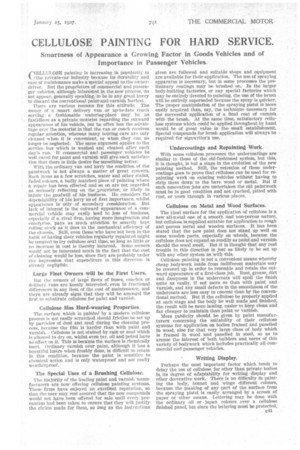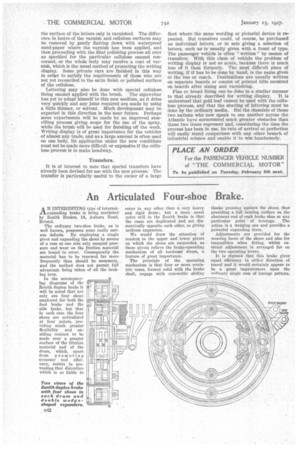CELLULOSE PAINTING FOR HARD SERVICE.
Page 65

Page 66

If you've noticed an error in this article please click here to report it so we can fix it.
Smartness of Appearance a Growing Factor in Goods Vehicles and of Importance in Passenger Vehicles,
rIELLULOSE painting is Increasing in popularity in 'Lithe private-car industry because its durability and ease of maintenance make a special appeal to the ownerdriver. But the proprietors of commercial and passenger vehicles, although interested in the new process, do not appear, generally speaking, to be in any great hurry to discard the conventional paint-and-varnish Method.
There are various reasons for this attitude. The owner of a smart delivery van or .up-to-date coach serving a fashionable • watering-place may be as fastidious as a private motorist regarding the outward appearance of his vehicle, but he often has the advantage over the motorist in that the van or coach receives regular attention, whereas many touring cars are only cleaned when it Is convenient, or when they can no longer be neglected. The same argument applies to the service bus which is washed and cleaned after each day's ran. If commercial and passenger vehicles be well cared for paint and varnish will give such satisfaction that there is little desire for something better.
With the ordinary van and lorry the condition of the paintwork is not always a matter of great concern. Such items as a few scratches, water and other stains, faded colours, a badly matched piece of painting -where a repair has been effected and so on are not regarded as serieusly reflecting on the_proprietor, or likely to Injure the goodwill of his business. He considers the dependability of his lorry as of first importance, whilst appearance i5 only of secondary eonsideration. But lack of interest in the outward Appearance of a commercial vehicle may easily lead to loss of business, especially if a: rival firm, having more imagination and enterprise, pays as much attention to smartly kept rolling steck as it does to the mechanical efficiency of the chassis. Still, even those who have not been in the habit of having their vehicles regularly repainted might be tempted to try cellulose next time, so long as little or no increase in coat is thereby incurred. Some owners would not be .interested much in the fact that the cost of cleaning would be less, since they are probably under the impression that expenditure in this direction is already negligible.
Large Fleet Owners will be the First Users.
But the owners of large fleets of buses, coaches or delivery vans are keenly interested,, even in fractional differences in any item. of the cost of maintenance, and there are already signs that they will be amongst the first to substitute cellulose for paint and varnish.
Cellulose Has Hard-wearing Properties.
The surface which is painted by a modern cellulose process is not easily scratched should friction be set up by particles of dust and mud during the cleaning process, because the film is harder than with paint and varnish. Cellulose is not stained by rain or mud which is allowed to dry on, whilst even tar, oil and petrol have no effect on it. This is because the surface is chemically inert. Ordinary varnish over paint, although it has a beautiful lustre when freshly done, is difficult to retain in this condition, because the paint is sensitive to chemical action and is only waterproof and not really weatherproof.
The Special Uses of a Brushing Cellulose.
The majority of the leading paint and varnish manufacturers are now offering cellulose painting systems. These firms have enjoyed an excellent reputation, so that the user may rest assured that the new compounds would not have been offered for sale until every precaution had been taken to ensure that they will justify the claims made for them, so .long as the instructions given are followed and suitable shops and equipment are available for their application. The use of spraying apparatus is necessary, but in some processes the preliminary coatings may be brushed on. In the larger body-building factories, or any special factories which may be entirely devoted to painting, the use of the brush will be entirely superseded because the spray is quicker. The proper manipulation of the spraying pistol is more easily acquired than, say, the technique necessary for the successful application of a final coat of varnish with the brush. At the same time, satisfactory cellulose systems which could be applied throughout by hand would be of great value in the small establishment. Special compounds for brush application will always be required for signsvriter's use.
Undercoatings and Repainting Work.
With some cellulose processes the undercoatings are similar to those of the old-fashioned system, but this, It is thought, is but a stage in the evolution of the new painting method. Still, the retention of these undercoatings goes to prove that cellulose can be used for repainting work on existing vehicles without having to strip them down to the bare wood or metal. But if such renovation jobs are undertaken the old paintwork must be in good condition and not cracked, pitted with rust, or worn through in various places.
Cellulose on Metal and Wood Surfaces.
The Ideal surface for the application of cellulose is a new all-metal one of a smooth and non-porous nature, but cellulose is supplied suitable for application to rough and porous metal and wooden surfaces. It has been stated that the new paint does not stand up well on some wooden parts, especially on wheels, because the cellulose does not expand so readily as paint and varnish should the wood swell. But it is thought that any real trouble In this direction is just as likely to be set up with any other system as with this.
Cellulose painting is not a convenient means whereby cheap bodywork made from indifferent materials may be covered up in order to resemble and retain the outward appearance of a first-class job. Rust, grease, dirt and dampness in the undercoats will spoil the finish quite as easily, if not more so than with paint and varnish, and any small defects in the smoothness of the undercoats are less easy to conceal than by the conventional method. But if the cellulose be properly applied at each stage and the body be well made and finished, the result will be more lasting, easier to keep clean and far cheaper to maintain than paint or varnish.
More publicity should be given by paint manufacturers concerning the suitability of their cellulose systems for application on bodies framed and panelled in wood, also for that very large class of body which is framed in wood and panelled in steel, so as to arouse the interest of both builders and users of this variety of bodywork which includes practically all commercial and passenger vehicles.
Writing Display.
Perhaps the most important factor which tends to delay the use of cellulose for other than private bodies is its degree of adaptability for writing display and other decorative work. There is no difficulty in painting the body, bonnet and wings different colours, because the masking of any part of the surface from the spraying pistol is easily arranged by a screen of paper or other means. Lettering may be done with the ordinary oil or japan colours over a cellulose finished panel, but since the lettering must be protected, c41
the surface of the letters only is varnished. The difference in lustre of the varnish and cellulose surfaces may be removed by gently flatting down with waterproof sand-paper where the varnish has been applied, and then proceeding with the final polishing process all over as specified for the particular cellulose enamel concerned, or the whole body may receive a coat of varnish, which is the usual method of protecting the writing display. Some private cars are finished in this way in order to satisfy the requirements of those who are not yet reconciled to the satin finish or polished surface of the cellulose.
Lettering may also he done with special cellulose lining enamel applied with the brush. The signwriter has yet to adapt himself to this new medium, as it dries very quickly and any joins required are made by using a little thinner, or solvent. Much development may be expected in this direction in the near future. Perhaps some experiments will be made by an improved stencilling process giving scope for the use 0 the spray, while the brush will be used for finishing off the work. Writing display is of great importance for the vehicles of almost any trade, and as a large amount is often used on one body, its application under the new conditions must not be made more difficult or expensive if the cellulose process is to make headway.
Transfers.
It Is of interest to note that special transfers have already been devised for use with the new process. The transfer is particularly useful to the owner of a large fleet where the same wording or pictorial device is repeated. But transfers could, of course, be purchased as individual letters, or in sets giving a selection of letters, such as is usually given with a fount of type. The passenger vehicle is often " written " by means of transfers. With this class of vehicle the problem of writing display is not so acute, because there is much less of it than formerly. The most difficult piece of writing, if it has to be done by. hand, is the name given to the bus or coach. Destinations are usually written on separate boards or consist of printed bills mounted on boards after sizing and varnishing.
Fine or broad lining can be done in a similar manner to that already described for writing display. It is understood that gold leaf cannot be used with the cellulose process, and that the shading of lettering must be done by the ordinary media. But the chemists of those two nations who now speak to one another across the Atlantic have surmounted much greater obstacles than these two items represent and, considering the time the process has been in use, its rate of arrival at perfection will easily stand comparison with any other branch of industrial science and enable it to win handsomely.












































































































